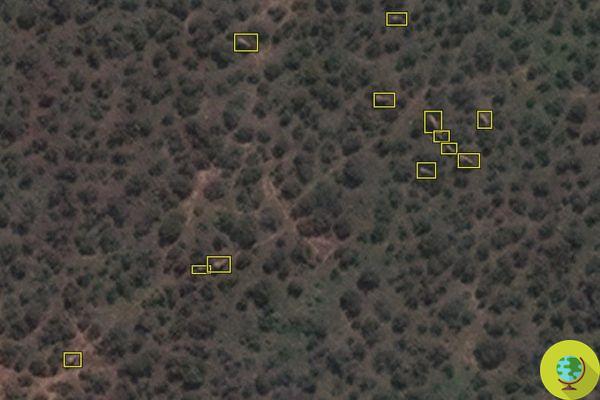As it orbits the earth, a satellite can collect over 5.000 km² of images in minutes
He is about to end up run over, his mother saves himSeen face to face they are mammoth yet they are fragile and in way of extinction. But observed from space they are little more than dots. We are talking about the elephants and the new initiative carried out by some universities that are literally counting pachyderms from space to save them from extinction.
Le satellite imagery developed with the help of computer algorithms devised at the University of Bath are a promising new tool for detecting wildlife that is in danger of disappearing forever, due to man. For the first time, scientists successfully used satellite cameras paired with other techniques to count animals in complex geographic landscapes, making a breakthrough in monitoring populations of endangered species.
For this research, the Worldview 3 and 4 satellites used high-resolution images to immortalize African elephants moving through forests and grasslands. The automated system detected the animals with the same accuracy as humans, without disturbing the elephants in the slightest given the great distances from which they are observed.
The algorithm that enabled the detection process was created by Dr Olga Isupova, a computer scientist at the University of Bath. Thanks to collaboration with colleagues from the University of Oxford and Twente in the Netherlands, scientists can now scan vast expanses of land in minutes, offering a valuable and valuable alternative to human observers who instead count individual animals from low-flying aircraft. quote.
While orbiting the earth, a satellite can collect over 5.000 km² of images in minutes, eliminating the risk of double counting. And in case of clouds, the step can be repeated the next day.
One more tool to save African elephants, increasingly threatened by poaching and habitat loss. With around 415.000 specimens so far estimated to be beautiful African savannah in the wild, the species is classified as endangered.
"Careful monitoring is essential if we are to save the species," said Dr Isupova. "We need to know where the animals are and how many there are."
Satellite monitoring eliminates the risk of disturbing animals during data collection. But not only. It is also easier to count elephants moving from one country to another, as satellites can orbit the planet regardless of border controls or conflicts.
However, this is not the first study to use satellite imagery and algorithms to monitor species, but it certainly was the first to reliably count animals moving through a heterogeneous landscape, i.e. a background that includes open meadows and woods.
“This type of work has been done before with whales, but of course the ocean is all blue, so counting is a lot less demanding,” said Dr Isupova. "As you can imagine, a heterogeneous landscape makes it very difficult to identify animals."
The researchers believe their work demonstrates the potential of the technology to help animals and more generally protect biodiversity and slow the progress of the sixth mass extinction, the ongoing extinction event triggered by human activity.

© 2020 Maxar Technologies via emote Sensing in Ecology and Conservation
'We need to find new, state-of-the-art systems to help researchers collect the data they need to save threatened species,' said Dr Isupova.
African elephants were chosen for this study for a very specific reason: they are the largest land animal and therefore the easiest to spot. However, Dr. Isupova hopes that it will soon be possible to detect much smaller species from space.

© 2020 Maxar Technologies via emote Sensing in Ecology and Conservation
"The resolution of satellite images increases every two years and with each increase we will be able to see smaller things in greater detail," he said.
The study was published in Remote Sensing in Ecology and Conservation.
Sources of reference: University of Bath, Remote Sensing in Ecology and Conservation
READ also:
- Namibia is auctioning 170 elephants at risk of extinction due to drought and conflict with humans
- This is how tourists kill elephants, for pleasure and treachery, for $ 30.000
- Sri Lanka, the harrowing images of elephants forced to search for food in the midst of mountains of waste


























